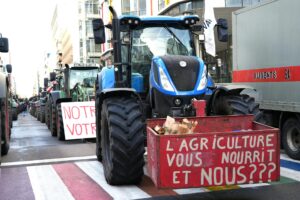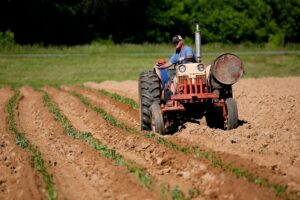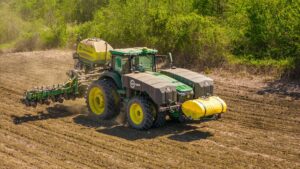When it comes to maintaining large properties, controlling overgrowth, or preparing land for agricultural or residential use, bush hogging is one of the most effective methods available. Whether you own several acres of land, manage a farm, or simply need an open field cleared, understanding what is bush hogging and how it can benefit you is crucial.
In this comprehensive guide, we’ll cover everything you need to know about bush hogging — including the basics, finding the right bush hogging services, bush hogging cost per acre, how much to charge if you’re offering these services, and even the best tractor for bush hogging. We’ll also introduce a trusted name in the industry: Sanders’ Land Management — experts in bush hogging, brush cutting, and light land clearing.
What Is Bush Hogging?
Bush hogging, sometimes referred to as “brush hogging,” is the process of clearing dense vegetation, thick brush, tall grass, and even small trees using a heavy-duty rotary mower known as a “bush hog.” This mower is typically attached to a tractor and is designed to handle rough terrain and thick material that ordinary lawnmowers can’t tackle.
In short, bush hogging transforms overgrown, wild land into manageable, usable space. It’s essential for property owners looking to maintain pastures, clear trails, control invasive species, or prepare a site for construction.
Why You Might Need Bush Hogging Services
If you’ve ever tried to clear dense brush with handheld tools, you know how overwhelming it can be. That’s where professional bush hogging services come into play. They offer several advantages:
- Efficiency: A professional service can clear acres in a fraction of the time it would take manually.
- Proper Equipment: Professionals use commercial-grade tractors and bush hogs, ensuring a cleaner, more thorough job.
- Experience: Knowing how to navigate slopes, ditches, and tough brush safely and effectively takes expertise.
- Cost-Effectiveness: When factoring in your time, labor, and equipment rental or purchase, hiring a pro often makes more sense financially.
Companies like Sanders’ Land Management specialize in bush hogging, brush cutting, and light land clearing, providing reliable services that deliver excellent results for residential, agricultural, and commercial clients.
How Bush Hogging Works
The process of bush hogging is fairly straightforward but requires skill and the right equipment:
- Inspection: Professionals first assess the land for hazards like rocks, stumps, and hidden debris that could damage the equipment or pose a safety risk.
- Planning: A mowing pattern is planned to ensure efficient coverage and minimize missed spots.
- Clearing: Using a powerful tractor with a bush hog attachment, the operator clears the land systematically.
- Finishing Touches: Depending on the project, additional services like brush cutting or minor grading may follow.
Bush Hogging Cost Per Acre: What to Expect
One of the most common questions people ask is, “What is the bush hogging cost per acre?” Like many services, the answer varies based on several factors:
- Terrain Difficulty: Steep slopes, rocky ground, and heavily wooded areas will cost more.
- Vegetation Density: Thicker brush requires more time and heavy-duty equipment.
- Accessibility: Remote or hard-to-reach areas can increase the overall price.
- Local Rates: Costs can vary significantly depending on the region and demand.
On average, bush hogging cost per acre typically ranges from $50 to $150 per acre. However, if the land is extremely overgrown, prices can climb up to $200 or more per acre.
For example, Sanders’ Land Management offers competitive pricing tailored to your property’s specific needs, ensuring top-quality results without breaking the bank.
How Much to Charge for Bush Hogging Per Acre: A Guide for Service Providers
If you’re looking to offer bush hogging services yourself, you might wonder, “How much to charge for bush hogging per acre?“
Here are some guidelines:
- Base Rate: Start around $75–$100 per acre for standard fields and light brush.
- Heavy Brush: Increase to $125–$200 per acre for dense vegetation.
- Additional Costs: Consider extra fees for setup, travel, hazard removal, or specialized equipment use.
When setting your pricing, be sure to factor in:
- Tractor maintenance and fuel
- Equipment wear and tear
- Your time and labor
- Business insurance
Many service providers also offer discounts for large properties (50 acres or more) or ongoing maintenance contracts.
Best Tractor for Bush Hogging: What You Need to Know
Choosing the best tractor for bush hogging is vital if you plan on clearing land yourself. Your tractor must be powerful, durable, and compatible with a rotary cutter.
Key Features to Look For:
- Horsepower: At least 40–60 HP for handling standard bush hogs; higher horsepower may be needed for dense brush.
- Stability: Wide wheelbases and four-wheel drive help on rough or uneven terrain.
- PTO (Power Take-Off): Essential for powering the bush hog.
- Hydraulics: Useful for lifting heavy implements or navigating tough terrain.
Top Tractor Models for Bush Hogging:
- John Deere 5E Series: Known for durability and strong performance.
- Kubota L Series: Highly versatile and user-friendly.
- Mahindra 5500 Series: Affordable with impressive power.
- New Holland Workmaster 70: Great for heavy-duty tasks.
Investing in the right tractor can make all the difference in the efficiency and quality of your bush hogging work.
Sanders’ Land Management: Your Go-To for Bush Hogging and More
When it comes to professional, reliable land management, Sanders’ Land Management stands out. Specializing in bush hogging, brush cutting, and light land clearing, Sanders’ team offers:
- Expertise: Years of experience handling all types of terrain and projects.
- Top Equipment: Utilizing only the best tractors and cutting tools.
- Customer Satisfaction: A commitment to meeting and exceeding client expectations.
Whether you need a single field mowed or dozens of acres cleared, Sanders’ Land Management has the tools, skills, and dedication you can trust.
Tips for Getting the Best Bush Hogging Results
To ensure the best outcome for your project, keep these tips in mind:
- Clear Debris First: Remove large rocks, wire, and trash before starting.
- Mark Hazards: Flag stumps, dips, and other hazards that could damage equipment.
- Choose the Right Season: Late fall or early spring are often ideal times to bush hog, as vegetation is manageable, and you can avoid disturbing wildlife during nesting seasons.
- Schedule Regular Maintenance: Regular bush hogging helps maintain property value and keeps invasive species in check.
Common Questions About Bush Hogging
Is bush hogging bad for the environment? When done responsibly, bush hogging can actually benefit ecosystems by preventing invasive plant spread and encouraging healthy regrowth. It’s important to avoid unnecessary clearing and leave native vegetation when possible.
How often should you bush hog a property? It depends on the land’s use. Pastures often require bush hogging 2–3 times a year, while wild land might only need it once annually.
Can I rent a bush hog instead of hiring a service? Yes, but renting equipment and doing it yourself is only advisable if you have experience operating tractors and navigating rough terrain.
Conclusion: Clear Your Land the Right Way
Bush hogging is an essential service for anyone dealing with large, overgrown properties. Whether you’re trying to maintain a pasture, prep land for construction, or simply regain control of your acreage, professional bush hogging services offer an efficient, cost-effective solution.
Remember to consider the factors that impact bush hogging cost per acre, choose the best tractor for bush hogging if going the DIY route, and don’t hesitate to reach out to trusted providers like Sanders’ Land Management for expert help in bush hogging, brush cutting, and light land clearing.
When you invest in proper land management, you’re investing in the future health, beauty, and usability of your property.



